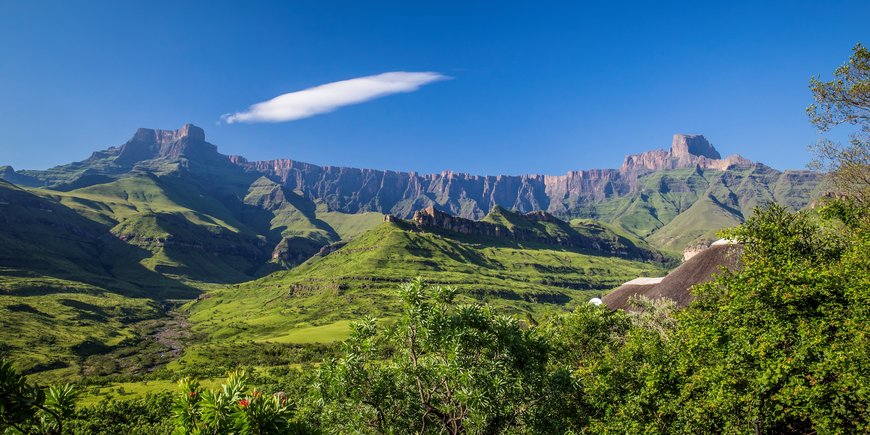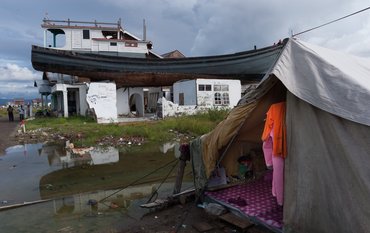A research team including GFZ scientists Sascha Brune, Jean Braun and Anne Glerum has tackled one of the most puzzling questions in plate tectonics: how and why ‘stable’ parts of continents gradually rise to form some of the planet’s greatest topographic features.
The new research, led by Thomas Gernon, Professor at the University of Southampton, addresses the effects of tectonic forces on the formation of 'Great Escarpments' over hundreds of millions of years. The researchers found that when tectonic plates break apart, strong wave-like processes deep inside the Earth are triggered that can lift the continental surface by more than a kilometre. Their findings help to explain why parts of the continents that were previously considered ‘stable’ experience significant uplift and erosion hundreds or even thousands of kilometres inland, such as the Central Plateau in South Africa. The results have now been published in the scientific journal Nature (DOI: s41586-024-07717-1).
Vertical movements of continental interiors are so far poorly understood
Plateaus are part of the oldest structures of the continents, the so-called cratons, which are several billion years old. These ancient continental structures are considered to be tectonically extremely stable. The vertical movements of these continental core areas are still among the least understood aspects of plate tectonics. Many of the cratonic continental fragments are bounded by steep landforms. One such immense and striking landform is the 'Great Escarpment', which runs along almost the entire coast of southern Africa and surrounds the plateaus there - in some cases at great distance. It was formed more than 120 million years ago with the break-up of the ancient continent Gondwana. Until now, it was assumed that the formation of cratonic plateaus and escarpments took place independently, as they are often spatially separated from each other - sometimes by more than thousand kilometres.
In order to investigate geological processes of this kind, the scientists have combined geological observations and statistical analyses with geodynamic simulations and landscape evolution models. The resulting physical model mechanistically links two phenomena, i.e. cratons and escarpments, to continental rifting.
One cause, multiple effects: the formation of diamonds, escarpments and plateaus
Methodologically, this work builds on a scientific study published in July last year, which investigated the connection between the occurrence of diamonds on the Earth's surface and the fragmentation of continents. The researchers discovered that when continents break apart, the stretching of the plate leads to movements in the Earth's mantle. This generates volcanism that brings diamonds to the surface, which originate from the upper mantle at depths of over 150 kilometres. Before a continental plate breaks apart, it thins out over the course of many millions of years, a process known as "rifting". During this process, the earth's surface sinks and forms a rift valley like in East Africa. At some point, seawater flows in, as is the case with the Red Sea. Similarly, the underside of the earth's plate changes. Pieces of the underside of the plate sink into the deep mantle, while hotter rock flows in from below into the space that is freed up. This results in melting processes: the previously viscoplastic rock becomes liquid and makes its way upwards, entraining diamonds to the earth's surface in the process. The currents along the underside of the earth's plates remove a considerable amount of rock that is dozens of kilometres thick. The chain reaction ultimately also reaches central regions of the continents that lie at great distances from rift zones.
In the newly published study, the team of scientists discovered that escarpments and plateaus are formed when instabilities in the Earth's mantle erode cratonic keels, causing the interior of the craton to rise. The instabilities in the Earth's mantle initially form where the continents break apart, near a rift valley. From there, the instabilities "migrate" along the lithospheric root at a rate of around 15-20 kilometres per million years towards the stable area of the continents (cratons), thereby gradually eroding the cratonic keels.
Uplift and the formation of plateaus occur when the cratons become lighter, i.e. when cooler, heavier parts of the cratonic keels fall into the deeper mantle. This can be imagined as when weight is dropped from a hot air balloon causing the balloon to rise. This process triggers a synchronised wave of uplift and erosion that lasts for tens of millions of years and spreads across the continent at a similar speed to the instabilities.
The team's study provides a new explanation for the puzzling vertical movements of cratons far from the edges of the continents. The deep levels of the Earth's plates can have a major influence on the development of Earth’s surface. The scientists were able to show that a single process - the successive detachment of the deep lithosphere - enables the formation of 'Great Escarpments’, the uplift of plateaus and erosion in the interior of the continent, as well as the volcanism that brings diamonds to the Earth's surface. In southern Africa, these phenomena occur up to a thousand kilometres apart and are therefore not easy to link. According to the study, cratons are more dynamic than previously assumed.
Original study: Gernon, T.M., Hincks, T.K., Brune, S. et al. Coevolution of craton margins and interiors during continental break-up. Nature 632, 327–335 (2024). https://doi.org/10.1038/s41586-024-07717-1



![[Translate to English:] Satellites with a striking terrain form, the Great Escarpment, which runs through the picture like a small, narrow mountain range](/fileadmin/_processed_/7/c/csm_Satellitenbild_Thomas_Gernon_Sentinel_f0be2ec685.jpeg)
![[Translate to English:] View of a rocky landscape, only a small withered shrub in the foreground](/fileadmin/_processed_/c/4/csm_Drakensberg1_J.Braun_62ad2f9ec1.jpeg)
![[Translate to English:] Landscape, brownish grass in the foreground, landscape/mountains marked by erosion in the background](/fileadmin/_processed_/8/9/csm_Drakensberg2_J.Braun_fc7f3e971e.jpeg)




![[Translate to English:] Fire in a forest, smoke rising, aerial view from above](/fileadmin/_processed_/8/3/csm_2025_01_06_AdobeStock_415831729_5a0e6d50d3.jpeg)









![[Translate to English:] [Translate to English:] Abror Gafurov von dem Schriftzug "Welcome to Azerbaijan" und den UN und COP Logos](/fileadmin/_processed_/2/5/csm_2024_11_Baku_COP29_Abror_Gafurov_1042faec82.jpeg)


![[Translate to English:] Martin Herold standing in front of the library on the Telegrafenberg](/fileadmin/_processed_/c/d/csm_Martin_Herold_d385ee4dd9.jpeg)
![[Translate to English:] Many people are listening to a presentation in the GFZ lecture hall.](/fileadmin/_processed_/c/a/csm_1_Bild1_hell_b9c0e9f5ed.jpeg)






![[Translate to English:] Both scientists sitting on stools in front of a wall of books in the Telegrafenberg library](/fileadmin/_processed_/6/6/csm_Buiter_Castell_DORA_4_e87cb1ea18.jpeg)
![[Translate to English:] Gruppenbild mit 4 Personen](/fileadmin/_processed_/8/d/csm_20241017_GFZ-Emmerman-Medal-005_web_reinhardtundsommer_21a414fa4a.jpeg)






![[Translate to English:] Ice landscape with five red tents](/fileadmin/_processed_/8/9/csm_Zeltlager_auf_dem_Eis_Urheberin_Jenine_McCutcheon_5ced2d523b.jpeg)